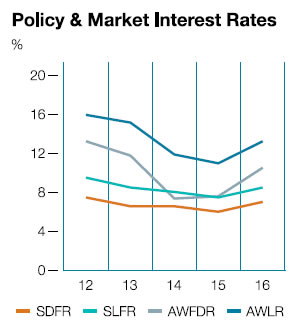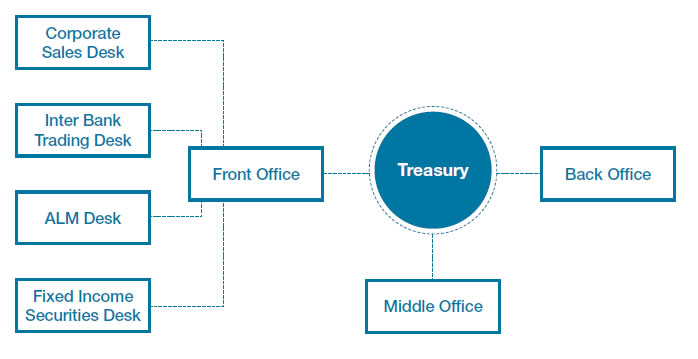Treasury
Our role encompasses management of the Bank’s Interest Rate Risk, Liquidity Risk and Forex Risk, playing a key role in managing margins. A market leader in Interbank FX and Fixed Income Securities market, our operations comprise Treasury Sales, Fixed Income Trading, Interbank & ALM with oversight responsibility for Treasury functions of the Bangladesh operations.


Treasury operations comprise three specialised areas, Forex & Corporate Sales, Fixed Income Securities trading and ALM Operations, each of which are headed by a Chief Dealer, who reports to the Head of Global Markets and Head of Global Treasury.
Fixed Income Securities
The Fixed Income Securities portfolio is managed to support liquidity of the Bank, while optimising earnings. Our portfolio is one of the largest in the country, making this a key component of our balance sheet, accounting for over 25% of total assets and over 7% of total liabilities.

Graph 51
CBSL tightened monetary policy during 2016 to curb inflation, monetary and credit expansion and the expected shortfall in tax revenue collections. Accordingly, the Statutory Reserve Ratio was increased by 150bps in January 2016 and policy interest rates twice by 50 bps on each occasion. Statutory Reserve Ratio (SRR), the Standing Deposit Facility Rate and the Standing Lending Facility Rate, stood at 7.50%, 7% and 8.5% respectively as at end 2016.
Market liquidity remained tight during the year, due to strong private sector credit growth and movement to higher yielding deposits. Liquidity remained tight throughout the year, exerting pressure on interbank rates, AWDR and AWPLR, moved up (Graph 52). Consequently, both lending and deposit rates moved up, although a lag in re-pricing and intense competition, gave rise to a marginal decline in NIM.
Upward movement of interest rates gave rise to fair value losses on re-measuring financial instruments available-for-sale, although interest income flows remain unaffected.

Graph 52
2016 also saw outflow of foreign investments from the bond market that added further pressure on treasury rates to move higher. In addition, CBSL also reduced their involvement in USD/LKR swap market, which also reduced rupee liquidity in the market.
Treasury also raised Rs.13 Bn. through two debenture issues, which were both oversubscribed on the opening day. This strengthened the Tier II capital requirements of the Bank, ensuring that we remain well above the regulatory requirements.
Foreign Exchange and Corporate Sales
This desk carried out FX trading operations, while supporting the Personal, Corporate Banking and Trade Finance businesses, managing the foreign exchange requirements of their customers and the Bank’s forex risk. Operations of this division are impacted mainly by movements in the exchange rate, the volume of import and export business and remittances channelled through the Bank.
The Sri Lankan Rupee devalued by 3.8% from Rs. 144.15 at the beginning of the year, to Rs.149.75 by the close of the year, a relatively stable performance compared to the 9% devaluation experienced in 2015. CBSL allowed greater flexibility in the determination of the exchange rate, opting to strengthen the country’s foreign exchange reserves. Higher imports and debt service payments, reversal of foreign investments in the Government Rupee Securities market and moderate growth of workers’ remittances, resulted in pressure on the exchange rate (Graph 53).
The Bank’s forex profit of Rs. 2.3 Bn reflects increased volumes of trade finance business and remittances. The Bank’s Treasury remains the market leader in Interbank FX Operations, providing liquidity in spot, forward and swap transactions.

Graph 53
ALM Operations
The Treasury was actively engaged in assets and liabilities management of the Bank’s balance sheet. The key objective is to ensure adequate liquidity for the Bank’s operations, while ensuring optimal pricing mechanism for its assets and liabilities.
The Treasury was actively engaged in ALCO activities and regularly provided strategic direction for banking operations given the liquidity constraints and pricing challenges faced. The Treasury was successful in mobilising foreign currency borrowings over US $ 200 Mn. in 2016, to support lending and investment activities of the Bank.

